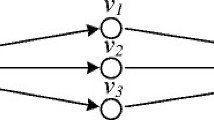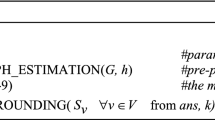Abstract
The influence maximization is an important problem in the field of social network. Informally it is to select few people to be activated in a social network such that their aggregated influence can make as many as possible people active. Kempe et al. gave a \((1-{1 \over e})\)-approximation algorithm for this problem in the linear threshold model and the independent cascade model. In addition, Chen et al. proved that the exact computation of the influence given a seed set is #P-hard in the linear threshold model. Both of the two models are based on randomized propagation, however such information might be obtained by surveys and data mining techniques. This will make great difference on the complexity of the problem. In this note, we study the complexity of the influence maximization problem in deterministic linear threshold model. We show that in the deterministic linear threshold model, there is no n 1−ε-factor polynomial time approximation for the problem unless P=NP. We also show that the exact computation of the influence given a seed set can be solved in polynomial time.
Similar content being viewed by others
References
Chen W, Yuan Y, Zhang L (2010) Scalable influence maximization in social networks under the linear threshold model. Microsoft TechReport Number MSR-TR-2010-133
Domingos P, Richardson M (2001) Mining the network value of customers. In: The 2001 international conference on knowledge discovery and data mining
Goldenberg J, Libai B, Muller E (2001a) Using complex systems analysis to advance marketing theory development. Acad Mark Sci Rev
Goldenberg J, Libai B, Muller E (2001b) Talk of the network: a complex systems look at the underlying process of word-of-mouth. Mark Lett 12(3):211–223
Granovetter M (1978) Threshold models of collective behavior. Am J Sociol 83(6):1420–1443
Kempe D, Kleinberg J, Tardos É (2003) Maximizing the spread of influence through a social network. In: The 2003 international conference on knowledge discovery and data mining, pp 137–146
Kempe D, Kleinberg J, Tardos É (2005) Influential nodes in a diffusion model for social networks. In: The 2005 international colloquium on automata, languages and programming, pp 1127–1138
Richardson M, Domingos P (2002) Mining knowledge-sharing sites for viral marketing. In: The 2002 international conference on knowledge discovery and data mining, pp 61–70
Schelling T (1978) Micromotives and macrobehavior. Norton, New York
Zou F, Zhang Z, Wu WL (2009) Latency-bounded minimum influential node selection in social networks. In: Lecture notes computer science, vol 5682, pp 519–526
Zou F, Willson J, Zhang Z, Wu W (2010) Fast information propagation in social networks. Discrete Math Algorithm Appl 2:125–141
Author information
Authors and Affiliations
Corresponding author
Rights and permissions
About this article
Cite this article
Lu, Z., Zhang, W., Wu, W. et al. The complexity of influence maximization problem in the deterministic linear threshold model. J Comb Optim 24, 374–378 (2012). https://doi.org/10.1007/s10878-011-9393-3
Published:
Issue Date:
DOI: https://doi.org/10.1007/s10878-011-9393-3




